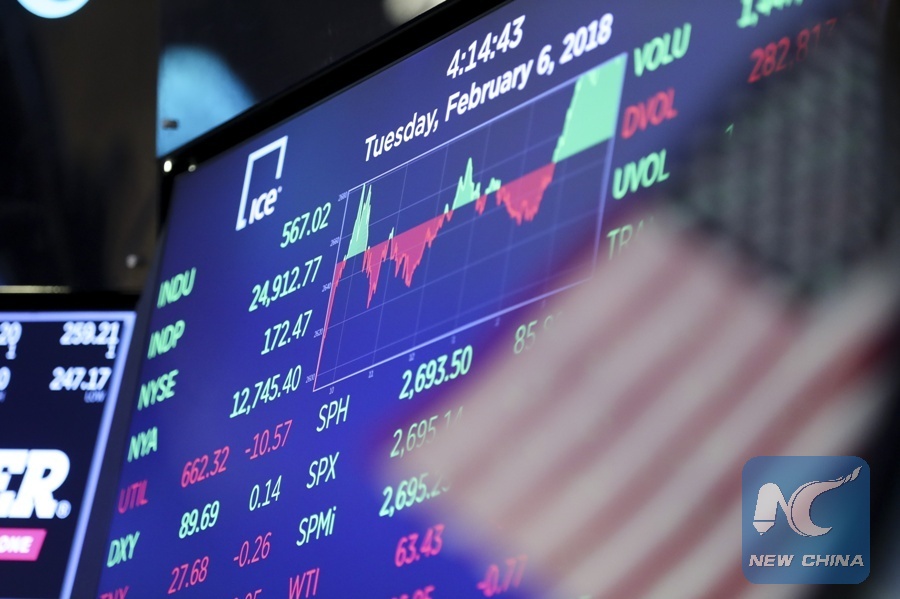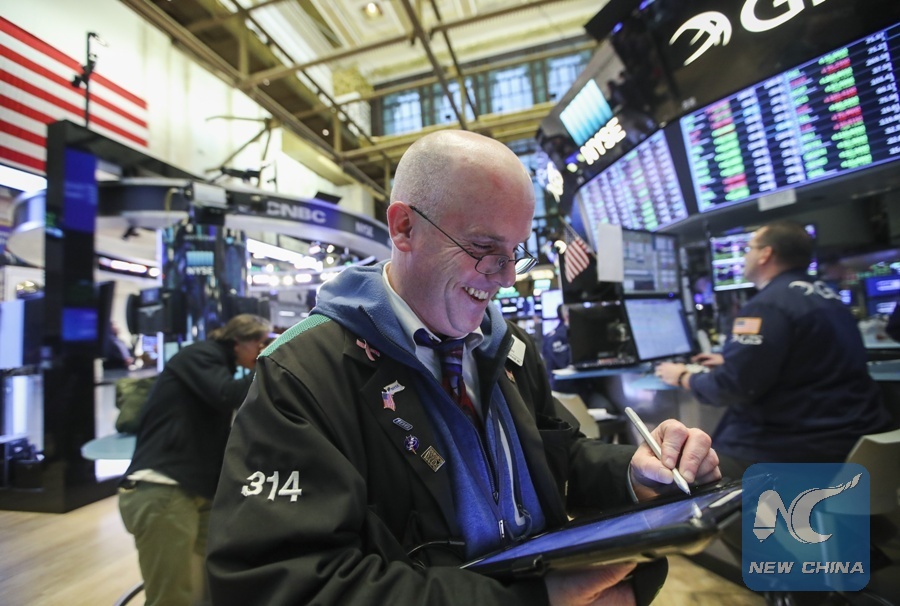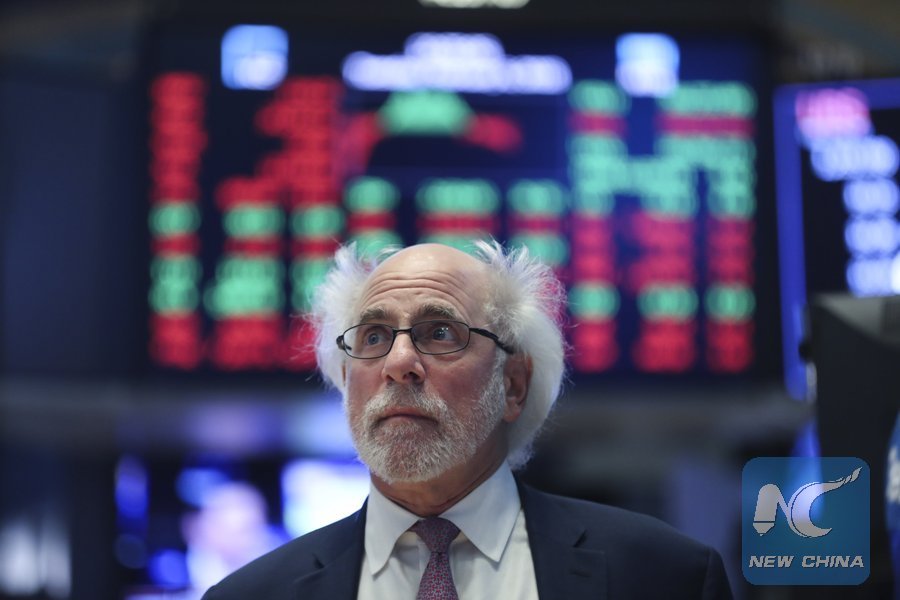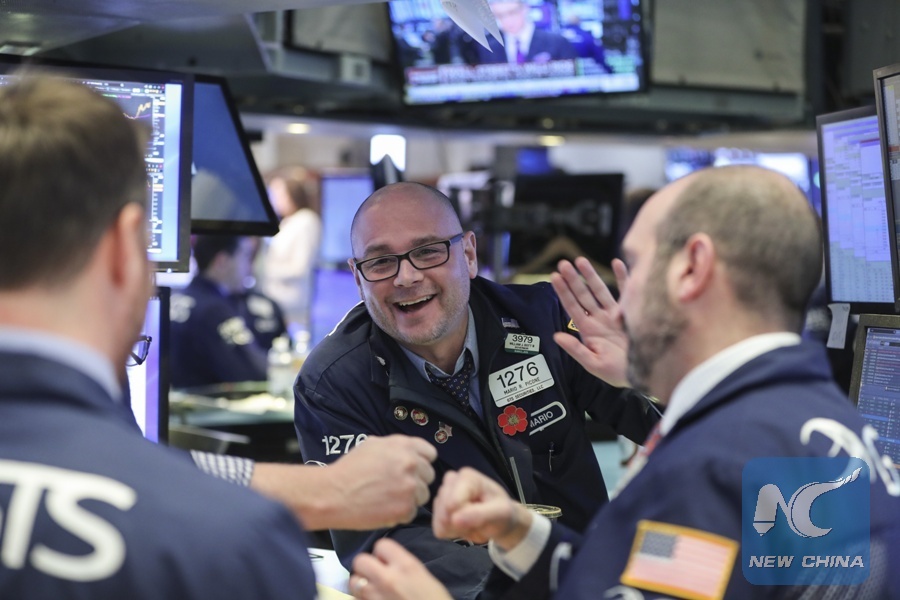
An electronic screen displaying trading data is seen at the New York Stock Exchange in New York, the United States, Feb. 6, 2018. (Xinhua/Wang Ying)
by Xinhua writers Wang Wen, Wang Naishui
NEW YORK, Feb. 6 (Xinhua) -- While U.S. stocks market experienced terrifying slide and a tremendous increase of volatility this week, analysts said it's not yet time to worry about a bear market as the correction was welcomed and long overdue.
The following three topics are typical of the equities market stories that have made the headlines around the world.
HEALTHY CORRECTION
Equity analysts said the sell-off that started on Friday was a healthy pause for the market that rallied crazily in January.

Traders work at the New York Stock Exchange in New York, the United States, Feb. 6, 2018. (Xinhua/Wang Ying)
"The market might finally have recognized that frothy valuations, tax reform notwithstanding, may not adequately account for endogenous risks such as Fed rate hike overshooting, let alone some geopolitical event that could derail the strong advance in equities since last year," said Humberto Garcia, head of Global Asset Allocation for Bank Leumi USA.
He said that the bank viewed the downturn as a transitory reckoning.
Likewise, President of Federal Reserve Bank of St. Louis James Bullard said Tuesday that it is "the most predicted sell-off of all time because the markets have been up so much and they have had so many days in a row without meaningful down days."
Some analysts said the wild swing the market staged on Tuesday might be signaling the worst is over.

A trader works at the New York Stock Exchange in New York, the United States, Feb. 6, 2018. (Xinhua/Wang Ying)
On Tuesday, all three major indices traded back and forth between positive and negative territory before locking in gains at the closing. The Dow added 567.02 points, or 2.33 percent, the S&P 500 increased 1.74 percent, while the Nasdaq went up 2.13 percent.
FED RATE HIKE UNCERTAINTY
The sell-off started on Friday last week was in part ignited by the average hourly earnings that jumped 2.9 percent year-on-year surprisingly on the day.
The Federal Reserve's core inflation indicator has confounded analysts for some time since they cannot explain why low unemployment and economic growth have not resulted in upward pressure on wages (with consequent general price increases that lead to inflation), Garcia pointed out, adding that investors might be startled by the report.
After the report came out, analysts said the market was thinking about the possibility for the Fed to raise interest rates four times instead of three.
Bullard tried to talk down inflation worry on Tuesday. He said continued strong labor market performance is unlikely to translate into meaningfully higher inflation, according to reports from Marketwatch.
Garcia said in his analysis that Friday's market reaction "drowned out the more dovish Fed statement issued after its Jan. 30-31 meeting, which implied that it does not expect inflation to reach 2 percent this year."
"Inflation on a 12-month basis is expected to move up this year and to stabilize around the Committee's 2 percent objective over the medium term," the Fed said in the statement.
However, Garcia said "the two-pronged target of full employment and stable prices mandated by Congress may become a tightrope walk with a balance sheet reduction program underway and the prospect of long-awaited inflation lurking."
The uncertainty is one of the major reasons that gave rise to investors' fears.
Analysts said further adding to the uncertainty is the incipient tapering of monetary accommodation at major central banks abroad, including the European Central Bank and the Bank of Japan.
BULL MARKET STAYS
U.S. equity valuations have been relatively high for some time. In fact, investors were worrying about the wide gap between the S&P 500 and European and Japanese stock market indices for all of 2017.
The stocks prices were pushed up faster than corporate earnings, and as some analysts pointed out the market had grown too comfortable with high valuations that it need some kind of correction to squeeze the bubbles out.

Traders work at the New York Stock Exchange in New York, the United States, Feb. 6, 2018. (Xinhua/Wang Ying)
For some analysts, Monday's sell-off well served the purpose and market risks were lowered in that sense as U.S. stocks became cheaper.
They said the sell-off was caused more by sentiment and fundamentals remained solid.
"There is nothing serious to worry about. The fundamentals of the economies of the United States, West Europe and China are all there and all good... (the) tax cut is not going away," said Peter Costa, president of Empire Executions,Inc.
Costa said he expected a 5-percent increase of the Dow by the end of the year.
J.P. Morgan said in a market commentary Tuesday that the bank still saw strong signs of growth at the global level.
"Growth remains synchronized, as 95 percent of developed and emerging economies reported expansionary Purchasing Managers' Index (PMI) surveys in January. Earnings growth expectations also continue to be strong for 2018 around the globe," according to the commentary.
Going forward, Garcia said "the equities in the major markets will resume their advance, though perhaps less aggressively, as evidence of the fiscal boost from the U.S. corporate tax cut becomes apparent and strong international markets continue to buoy U.S. exports, and vice versa."

